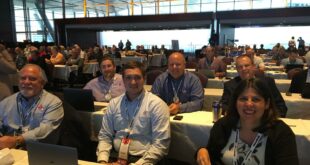
Higher Standards
As the May/June 2023 issue of Sprinkler Age will be available at the NFPA Annual Conference and Expo® in Las Vegas, this column will serve a special purpose. In preparation for the 2023 NFPA Technical Meeting, AFSA has reviewed the posted Certified Amending Motions (CAM) for the relevant standards on the Fall 2022 (F2022) and Annual 2023 (A2023) revision cycles and is providing a voting guide for our members as a special Higher Standards column.
NFPA 14, Standard for the Installation of Standpipe and Hose Systems
 CAM 14-10 – Vertical Standpipe System Zones Beyond the Pumping Capabilities of the Fire Department
CAM 14-10 – Vertical Standpipe System Zones Beyond the Pumping Capabilities of the Fire Department
Reject Second Revision No. 36
AFSA Position: SUPPORT
This CAM moves to reject SR-36. If the CAM passes, zones partially above the pumping capabilities of the fire department would not need to be provided with an FDC.
Zones partially beyond the pumping capabilities of the fire department do not need to be provided with an FDC. This cycle, there was a substantial effort to codify redundancy in very tall buildings that exceed the pumping capabilities of the fire department. Because the fire department’s capabilities are limited, the pressure discharged from the automatic water supplies will exceed the fire department’s pumping pressure, and the fire department will not be able to overcome the pressure differential in the check valve. While the fire department could theoretically partially supply a zone, it is not possible unless there is a failure of two automatic supplies. The presence of an FDC that feeds a zone that the fire department will never be able to supply adds an unnecessary cost to the system, and it is irresponsible to require a fire protection feature that provides no material value. While there are arguments that fire department capabilities may improve in the future, the purpose of a minimum standard is to supply the appropriate devices and appurtenances based on the criteria available at the time of design and installation.
 CAM 14-14 – Lockable Hose Connection Caps
CAM 14-14 – Lockable Hose Connection Caps
Accept an Identifiable Part of Correlating
Comment No. 89
AFSA Position: WITHDRAWN
Lockable caps on standpipe hose connections pose a risk to fire and life safety where they are installed without adequate coordination with the appropriate stakeholders. Unless lockable hose caps are required by the Authority Having Jurisdiction (AHJ) and local fire department, lockable hose caps are not permitted, and their presence could delay the firefighting operations of the responding fire department and place the firefighter, building, and occupants at risk.
This CAM was initially submitted by AFSA to make sure that lockable hose connection caps could be installed on standpipe systems with AHJ approval. Based on the rules to submit a notice of intent to make a motion (NITMAM), the available language for consideration was limited. Fortunately, a task group was formed to address this issue through a tentative interim amendment (TIA). Based on the discussions during the task group meetings, this CAM has been withdrawn.
 CAM 14-17 – Breach Control Valves
CAM 14-17 – Breach Control Valves
Reject Second Revision No. 28
AFSA Position: OPPOSE
This CAM moves to reject SR-28. If the CAM passes, the requirement that prohibits automatic breach control valves from being installed on standpipe systems would be removed.
From one manufacturer’s website, breach control valves are “designed to automatically isolate portions of distribution piping when a catastrophic downstream breach or line break occurs.” This is a great design feature for MEP infrastructure, but for water-based fire protection systems that function as a life safety system, it is paramount that essential devices used in those systems are listed for fire protection use. Large volumes of water may be necessary to control a fire protected by a deluge or preaction system, and there is no prescriptive guidance available to determine what the maximum acceptable flow might be in a water-based fire protection system. To date, there are no breach control valves that have been evaluated or listed for use in fire protection systems.
 CAM 14-18 – Hose Connection Caps & Rated Pressure
CAM 14-18 – Hose Connection Caps & Rated Pressure
Reject Second Revision No. 35
AFSA Position: SUPPORT
This CAM moves to reject SR-35. If the CAM passes, the requirement for an 1/8-in. or larger hole to be drilled into hose connection caps if the cap is not listed for the maximum pressure at the hose connection would be removed.
When installed on standpipe systems, hose connections are required to have their threads protected. There is no requirement to provide a cap on hose connection outlets. Additionally, brass hose connection caps that are found on hose valves are not evaluated as part of the listed assembly, and there are several other options on the market to protect hose threads that do not require mechanically altering a component in the field. The Technical Committee cites that there are concerns with cap failures if subject to pressure from an open hose valve, but negative comments on the second revision cite that there is no supporting data and that it is unclear whether the additional orifice should be provided by the manufacturer or the installer. While there is a concern that deficient hose valves could leak by and create pressure between the gate and the cap, the requirement for a “listed” cap is too strong and the cap should only need to be rated for the maximum pressure at the hose connection. AFSA supports this CAM so that better language can be developed for the next edition of NFPA 14.
NFPA 4, Standard for Integrated Fire Protection and Life Safety System Testing
 CAM4-1 – Active Fire Protection Systems
CAM4-1 – Active Fire Protection Systems
Reject Second Revision No. 2
AFSA Position: OPPOSE
This CAM moves to reject SR-2. If the CAM passes, the requirements that clarifiy that only active fire protection systems need to be tested for integration would be removed.
To truly understand the context of this proposal, it is imperative to identify the purpose of both NFPA 3 Standard for Commissioning of Fire Protection and Life Safety Systems as well as NFPA 4. NFPA 3 verifies that individual fire protection and life safety systems conform to minimum standards plus project specific requirements, where NFPA 4 verifies that integrated systems operate and function in the appropriate sequence of operation and in conformance with the minimum standards, project specific requirements, and manufacturer’s instructions. The language, as proposed in SR-2, appropriately distinguishes the differences between active and passive fire protection systems. There is no integration with a passive fire protection system. By the definitions in NFPA 3 and NFPA 4, passive fire protection systems do not require any type of system activation or movement. There is no sequence of operations for passive fire protection features. Fire stopping and fire walls commissioned under NFPA 3 have no bearing on the communication between sprinkler systems, waterflow devices, alarm initiating devices, and control panels that may signal the operation of a fire damper, smoke evacuation system, or other active fire protection system. Ultimately, there is no need to verify the integration of passive fire protection systems in a building as they are already commissioned through the requirements of NFPA 3.
Other CAMs
NFPA 4 and NFPA 14 are not the only standards being debated at the NFPA Technical Meeting, but they are the only standards directly relevant to our membership. AFSA encourages NFPA members in attendance to listen to the debate on the other CAMs to cast an informed vote.
2023 NFPA Annual Conference & Expo®
The Technical Meeting will begin on Thursday, June 22, 2023, at 8:00 a.m. with the presentation of committee service and special achievement awards. Afterwards, presentation and debate of CAMs will begin. If needed, the meeting may continue on Friday, June 23, 2023, to allow additional time for full debate and action. According to the NFPA website, final details of the Technical Meeting scheduling, as well as the full agenda of all CAMs to be debated and acted upon each day, is posted online at www.nfpa.org/Events/Events/Technical-Meeting.
In addition to AFSA’s technical services staff’s participation in the Technical Meeting, we will be alongside AFSA’s membership team in the AFSA booth in the expo hall. Feel free to stop by and discuss a technical topic, ask a membership question, or just to say hi. Last year, our team answered several Technical Reviews right on the expo floor! We look forward to seeing our members there. Visit nfpa.org for more information and to register for the conference.
 ABOUT THE AUTHOR: Kevin Hall, M.Eng., P.E., ET, CWBSP, PMSFPE, is the senior manager of engineering and technical services for the American Fire Sprinkler Association (AFSA). He is a member of several National Fire Protection Association (NFPA) technical committees responsible for developing the model codes and standards, including, NFPA 1 Fire Code, NFPA 13/13R/13D Installation of Sprinkler Systems, NFPA 20 Installation of Stationary Fire Pumps for Fire Protection, NFPA 30 Flammable and Combustible Liquids Code, and NFPA 915 Remote Inspections. He also represents AFSA on numerous UL standard technical panels responsible for revising and maintaining the product standards used in the sprinkler industry. He is a registered professional engineer in Delaware and Maryland, NICET III certified in water-based system layout, a certified water-based system professional through NFPA, and a professional member of the Society of Fire Protection Engineers (SFPE). He earned his Bachelor of Science and Master of Engineering degrees from the University of Maryland College Park in fire protection engineering. In 2021, he was recognized as one of SFPE’s “5 Under 35” award recipients. Prior to his association and committee work, he worked for Reliance Fire Protection in Baltimore, Maryland as a project manager overseeing projects of various sizes and complexity for the Contracts Division.
ABOUT THE AUTHOR: Kevin Hall, M.Eng., P.E., ET, CWBSP, PMSFPE, is the senior manager of engineering and technical services for the American Fire Sprinkler Association (AFSA). He is a member of several National Fire Protection Association (NFPA) technical committees responsible for developing the model codes and standards, including, NFPA 1 Fire Code, NFPA 13/13R/13D Installation of Sprinkler Systems, NFPA 20 Installation of Stationary Fire Pumps for Fire Protection, NFPA 30 Flammable and Combustible Liquids Code, and NFPA 915 Remote Inspections. He also represents AFSA on numerous UL standard technical panels responsible for revising and maintaining the product standards used in the sprinkler industry. He is a registered professional engineer in Delaware and Maryland, NICET III certified in water-based system layout, a certified water-based system professional through NFPA, and a professional member of the Society of Fire Protection Engineers (SFPE). He earned his Bachelor of Science and Master of Engineering degrees from the University of Maryland College Park in fire protection engineering. In 2021, he was recognized as one of SFPE’s “5 Under 35” award recipients. Prior to his association and committee work, he worked for Reliance Fire Protection in Baltimore, Maryland as a project manager overseeing projects of various sizes and complexity for the Contracts Division.

 Sprinkler Age A Publication of the American Fire Sprinkler Association
Sprinkler Age A Publication of the American Fire Sprinkler Association
